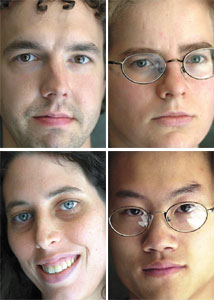|
HOME | SEARCH | ARCHIVE |
|
Special
Issue: Web Site Helps Families, Friends Track Loved Ones
![]()
by Robert Sanders and Cyrus Farivar
| |  Eric Fraser, Miriam Walker, Jennifer Mankoff, and Ka-ping Yee, (clockwise from top left) set up the Millennium site within hours of Tuesday's attack. |
20 September 2001
|
Miriam Walker’s personal Web page quietly urges: “get involved.” The morning of the terrorist attacks on the East Coast, that’s exactly what she did. After a roommate failed repeatedly to connect by phone with friends in New York, she called fellow computer science graduate student Ka-Ping Yee for help in creating a Web site where people in the affected areas could post messages about their status. “It seemed that if one person could report in and say they were OK, everyone else could get that information,” Walker, 24, told the Los Angeles Times in one of many interviews she did over the ensuing days. “It would reduce traffic on the telephone lines and allow the information to reach people faster.” By Tuesday afternoon, seven hours after the first airplane struck the World Trade Center, the site was up and running on the campus’s Millennium Cluster, a high-powered array of PCs able to deal with high-volume Internet traffic. Peter Jennings mentioned the site on ABC. CNN, Yahoo, and MSNBC posted the Web address — safe.millennium.berkeley.edu — on their Internet sites. The Associated Press ran a story. And locally, KGO-TV interviewed Walker and Yee. The media attention paid off. By Tuesday evening, the Web site had some 370,000 hits. By Friday, it had two million hits, and more than 30,000 messages. “We thought we’d get a lot of traffic, but not this much,” said Eric Fraser, manager of the Millennium Cluster. The Web site lets people query those who post messages, and also collects data from similar sites around the country. Ping did the programming for the initial site, learning a database programming language in the process. “I was really, really shocked about what happened. I didn’t just want to stand by and do nothing,” Yee said. “I wanted to let people have a conversation.” The raw, hurried messages tell stories of relief and desperation, luck and tragedy. One woman sought information on someone who worked on 105th floor of South Tower, a floor from which apparently no one escaped. Another pleaded: “I am a tourist in america and (w)as in the building at the time if the incident i was with three friends Armyo?? Gump??? harry??? Please PLease get in touch if you are alive! I am very badly injured but will live.” Among the reports on the injured: “He’s my girlfriend’s brother. She has seen him and been with him at the hospital in NYC. He’s doing well. His leg is swollen and they are relieving the pressure. His kidneys are fine and we hope to have him back home in a week. Others were thankful for a lucky escape. One woman wrote, “Robert Scott works for the Port Authority on the 72nd floor of the N tower. He made it out alive and is home safe with his family in Queens.” Another note told of a lucky Pentagon employee. “Wil was on leave the day of the attack and was safe at home with me. Our hearts go out to all the victims, please keep them in your prayers." And finally, a reminder that, for many, the nightmare is not over. “BOB IS A NYC FIREMAN AND CAME HOME LATE LAST NIGHT TO HIS HOME IN SEAFORD, LONG ISLAND. TODAY HE IS BACK IN NY.” As Yee and Walker improved the site, they also attended classes. In spare moments, they fielded calls from reporters. Yee, a second-year graduate student from Winnipeg, was interviewed by the Canadian Broadcasting Corporation and the Canadian news magazine Maclean’s. Walker, a graduate student from New Zealand, was contacted by a New Zealand TV network. And NBC’s Today Show dropped by Thursday to interview the pair. “I think everyone was looking for some way to help. Everyone on the West Coast felt very isolated,” said Jennifer Mankoff, an assistant professor of computer science. Mankoff has family in the New York area and assisted the students in constructing the site. “We came up with something to help out.”
Home | Search | Archive | About | Contact | More News
Copyright 2000, The Regents of the University of California.
Produced and maintained by the Office of Public Affairs at UC Berkeley.
Comments? E-mail berkeleyan@pa.urel.berkeley.edu.